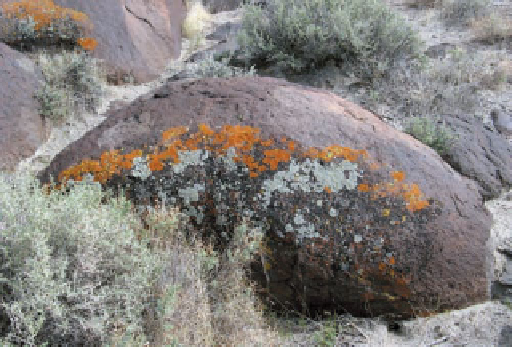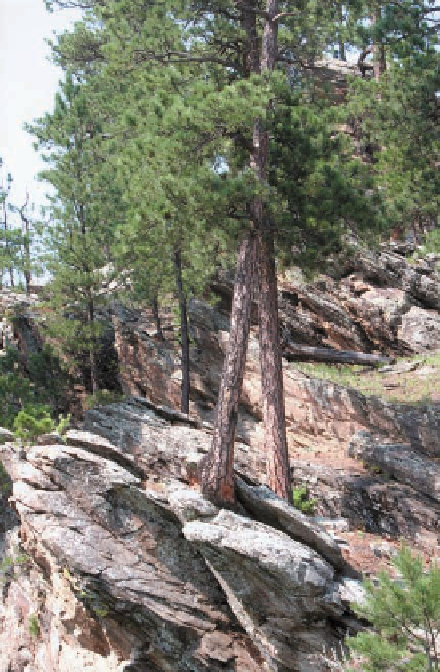Geology Reference
In-Depth Information
◗
Figure 6.5
Organisms and Weathering
a
The orange and gray masses on this rock at Grimes Point
Archaeological Site in Nevada are lichens, composite organisms
made up of fungi and alage. Lichens derive their nutrients from the
rock and thus contribute to chemical weathering.
decomposed during chemical weathering, but some chem-
ically stable minerals are simply liberated from the parent
material.
Important agents of chemical weathering include atmo-
spheric gases, especially oxygen, water, and acids. Organisms
also play an important role. Rocks with lichens (composite
organisms made up of fungi and algae) on their surfaces
undergo more rapid chemical alteration than lichen-free
rocks (Figure 6.5a). In addition, plants remove ions from soil
water and reduce the chemical stability of soil minerals, and
plant roots release organic acids.
When
solution
takes place, the ions of a substance
separate in a liquid, and the solid substance dissolves. Wa-
ter is a remarkable solvent because its molecules have an
asymmetric shape, consisting of one oxygen atom with two
hydrogen atoms arranged so that the angle between the
two hydrogen atoms is about 104 degrees (
b
These trees in the Black Hills of South Dakota
contribute to mechanical weathering as they grow in cracks
in the rocks, thereby breaking the parent material into
smaller pieces.
make water acidic is by dissociating the ions of carbonic
acid as follows:
H
2
O + CO
2
m
H
2
CO
3
m
H
+
+ HCO
3
-
water
carbon
carbonic
hydrogen
bicarbonate
dioxide
acid
ion
ion
◗
Figure 6.6).
Because of this asymmetry, the oxygen end of the mol-
ecule retains a slight negative electrical charge, whereas
the hydrogen end retains a slight positive charge. When a
soluble substance such as the mineral halite (NaCl) comes
in contact with a water molecule, the positively charged
sodium ions are attracted to the negative end of the wa-
ter molecule, and the negatively charged chloride ions
are attracted to the positively charged end of the molecule
(Figure 6.6). Thus, ions are liberated from the crystal structure,
and the solid goes into solution; in other words, it dissolves.
Most minerals are not very soluble in pure water
because the attractive forces of water molecules are not suf-
fi cient to overcome the forces between particles in miner-
als. The mineral calcite (CaCO
3
), the major constituent of
the sedimentary rock limestone and the metamorphic rock
marble, is practically insoluble in pure water, but it rapidly
dissolves if a small amount of acid is present. One way to
According to this chemical equation, water and carbon
dioxide combine to form
carbonic acid
, a small amount of
which dissociates to yield hydrogen and bicarbonate ions.
The concentration of hydrogen ions determines the acidity
of a solution; the more hydrogen ions present, the stronger
the acid.
Carbon dioxide from several sources may combine with
water and react to form acid solutions. The atmosphere is
mostly nitrogen and oxygen, but approximately 0.03% is
carbon dioxide, causing rain to be slightly acidic. Decaying
organic matter and the respiration of organisms produce
carbon dioxide in soils, so groundwater is also generally
slightly acidic. Climate affects the acidity, however, with arid
regions tending to have alkaline groundwater (that is, it has a
low concentration of hydrogen ions).
Whatever the source of carbon dioxide, once an acidic
solution is present, calcite rapidly dissolves according to the
reaction.




Search WWH ::

Custom Search